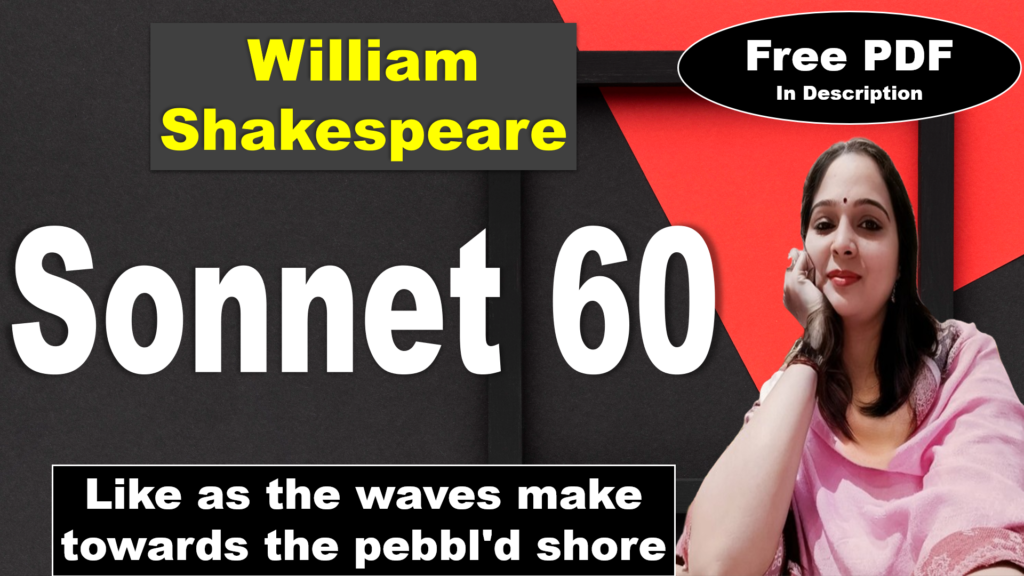
Sonnet 60 by William Shakespeare Questions Answers
Very Short Answer Questions
What is the poem’s theme?
The fleeting nature of time and beauty.
What does the speaker compare the passage of time to?
The waves crashing against the shore.
What happens to each moment in time?
It is replaced by the next moment.
What does the speaker use to describe the journey from infancy to adulthood?
The word “crawls”.
What does the speaker use to represent the dark shadow that old age casts over youth?
The metaphor of eclipses.
What does the speaker personify time as?
A giver who eventually takes back his gift.
What does the speaker use to describe the physical effects of aging?
Wrinkles.
What does the speaker compare time to in line 12?
A scythe.
What does the speaker find solace in?
The hope that his poetry will endure.
What does the speaker hope his poetry will do?
Immortalize his beloved’s beauty.
What is the tone of the poem?
Melancholy and reflective.
What is the rhyme scheme of the poem?
ABAB CDCD EFEF GG
What is the meter of the poem?
Iambic pentameter.
What are some of the literary devices used in the poem?
Metaphor, personification, simile.
What is the significance of the poem’s title?
The title is simply the number of the sonnet.
Who is the speaker of the poem?
The speaker is a man who is lamenting the passage of time and the loss of his beloved’s beauty.
Who is the audience of the poem?
The poem is addressed to the speaker’s beloved.
What is the speaker’s attitude toward the subject matter?
The speaker is sad and resigned about the passage of time, but he also finds solace in the hope that his poetry will endure.
What is the overall message of the poem?
The poem is a reminder that time is fleeting and that beauty is impermanent.
Short Answer Questions
1. What is the poem’s theme?
The poem’s theme is the fleeting nature of time and beauty. The speaker laments the fact that everything is eventually consumed by time, including youth and beauty.
2. What does the speaker compare the passage of time to?
The speaker compares the passage of time to the waves crashing against the shore. He suggests that just as the waves relentlessly move towards the shore, so too does time move relentlessly forward, eventually consuming everything in its path.
3. What is the speaker’s attitude toward the subject matter?
The speaker’s attitude toward the subject matter is bittersweet. He is saddened by the fact that time and beauty are fleeting, but he also finds solace in the hope that his poetry will endure, even as he is consumed by time’s relentless march.
4. What is the overall message of the poem?
The poem is a reminder that time is fleeting and that beauty is impermanent. However, it also suggests that art can transcend time and preserve beauty, even in the face of death.
5. What are some of the literary devices used in the poem?
The poem uses a number of literary devices, including metaphors, similes, and personification. For example, the speaker compares time to waves and a scythe, and he describes beauty as being “crown’d” with maturity.
6. What is the significance of the poem’s title?
The poem’s title is simply the number of the sonnet. However, the number 60 is associated with wisdom and experience, which are both relevant themes in the poem.
7. Who is the speaker of the poem?
The speaker of the poem is a man who is lamenting the passage of time and the loss of his beloved’s beauty. He is a poet who believes in the power of art to transcend time and preserve beauty.
8. Who is the audience of the poem?
The poem is addressed to the speaker’s beloved. However, it can also be read as a message to all readers about the fleeting nature of time and beauty.
9. What is the speaker’s tone?
The speaker’s tone is melancholic and reflective. He is saddened by the passage of time and the loss of his beloved’s beauty. However, he also finds solace in the hope that his poetry will endure.
10. What is the meter of the poem?
The poem is written in iambic pentameter, which is a metrical pattern consisting of five metrical feet, each of which consists of an unstressed syllable followed by a stressed syllable. This gives the poem a regular and flowing rhythm.





